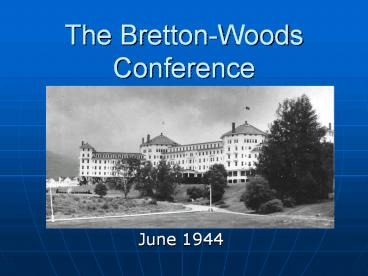The Bretton-Woods Conference - PowerPoint PPT Presentation
Title:
The Bretton-Woods Conference
Description:
The Bretton-Woods Conference June 1944 Founders Harry Dexter White -Chief International Economist at the U.S. Treasury John Maynard Keynes U. K. Treasury Advisor ... – PowerPoint PPT presentation
Number of Views:1826
Avg rating:3.0/5.0
Title: The Bretton-Woods Conference
1
The Bretton-Woods Conference
- June 1944
2
Founders
- Harry Dexter White -Chief International Economist
at the U.S. Treasury - John Maynard Keynes U. K. Treasury Advisor
3
44 Delegate Nations
- Australia India
- Belgium Iran
- Bolivia Iraq
- Brazil Liberia
- Canada Luxembourg
- Chile Mexico
- China Netherlands
- Colombia New Zealand
- Costa Rica Nicaragua
- Cuba Norway
- Czechoslovakia Panama
- Dominican Republic Paraguay
- Ecuador Peru
- Egypt Philippines
- El Salvador Poland
- Ethiopia Union of South
Africa - France Union of Soviet
Socialist Republics (USSR) - Greece United Kingdom
- Guatemala United States
4
Major Accomplishments
- International Monetary Fund
- International Bank for Reconstruction and
Development - (focus on IMF)
5
Policies of the Depression era
- High tariff barriers
- Competitive currency devaluations
- Discriminatory trading blocs
These policies adopted after WWI created an
unstable international environment
Bretton-Woods goal sustainable peace and
prosperity through economic cooperation
6
International Monetary FundMonetary Policy
- Fixed exchange rates
(The U.S. dollar tied to gold at 35 an ounce) - 1) Restrained monetary expansion
- a) Loss of international
reserves by foreign banks meant
banks would be unable to maintain the
fixed dollar exchange rate. - b) U.S. obligation to redeem foreign
accumulation of dollars for gold
restricted U.S. monetary growth.
7
Creation of the Fund
- Member countries contributed there currencies and
gold to the fund. - From this the IMF could lend to countries
experiencing balance of payment difficulties
(short-term) avoiding currency devaluation. - If necessary changes in the exchange rate could
be made. - An adjustable exchange rate was not available to
the U.S. dollar
8
Convertible Currency
- Convertible currency - one that may be freely
exchanged for foreign currencies. - Increased efficiency for multilateral trade.
- The U.S. and Canada became convertible in 1945
- Most European Countries waited until 1958, Japan
followed in 1964
9
World Currency
- Its ease of conversion and the prominence given
to it from the Bretton-Woods agreement quickly
gave rise to the U.S. dollar as the world reserve
currency. - International trade was conducted in dollar
denominations. - Foreign central banks held their international
reserves in dollar assets.
10
Balance of Payment Crises
- Fundamental Disequilibrium was thought to exist
when a country maintained a continuing current
account deficit. - This may lead to a devaluation of the currency.
Anyone holding this currency would incur a loss
equal to the amount of the exchange rate change.
11
- Large current account surpluses made countries
candidates for revaluation. - Selling local currency in the foreign exchange
market with the intent of slowing appreciation
resulted in large official reserves. - Money supply would grow to quickly which in turn
would push up the price level and disrupt the
internal balance.
12
Fall of Bretton-Woods
- Increasing balance of payment crises.
- U.S. currency pressure brought about partly from
cost of Vietnam War and a growing trade deficit. - President Nixon issued an executive order in
1971 eliminating the gold standard and devaluing
the dollar. - Floating exchange rates determined by market
trading replaced fixed exchange rates.






























